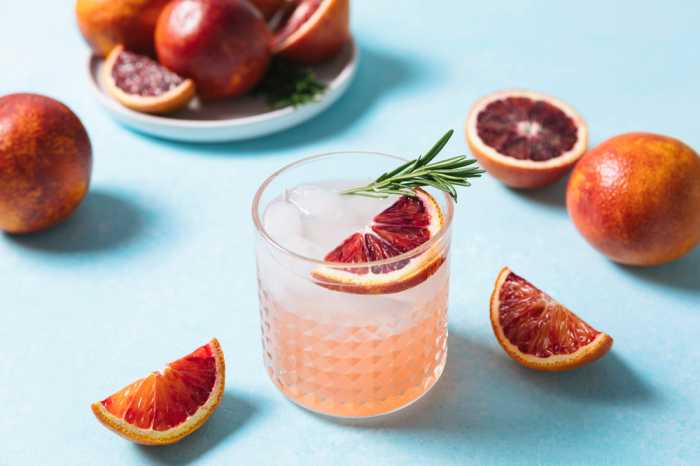Mixologists and bartenders have always prided themselves on their ability to craft delicious cocktails that are both visually stunning and packed with flavor. However, with the growing trend of non-drinkers and health-conscious individuals, a new category of cocktails is taking the stage – mocktails.
The popularity of mocktails has skyrocketed over the past few years as more and more people choose to abstain from alcohol or simply opt for a healthier lifestyle. These alcohol-free beverages are designed to provide all the sensory experiences of a traditional cocktail, without any of the buzz.
Mocktails are the perfect choice for a variety of occasions. From brunches and baby showers to business meetings and family gatherings, these drinks offer a wide range of flavors and tastes to suit every palate. What’s more, they are incredibly versatile, allowing mixologists to experiment with unique flavors and ingredients to create truly one-of-a-kind drinks.
Another significant factor driving the growing popularity of mocktails is the availability of high-quality, non-alcoholic spirits and mixers. Companies such as Seedlip and Lyre’s have made it their mission to create complex, flavorful spirits that are perfect for use in mocktails.
Whether you’re looking to cut down on your alcohol consumption, or simply enjoy a delicious, alcohol-free beverage, mocktails are a great choice. With a little creativity and experimentation, it’s easy to craft drinks that are both flavorful and visually stunning.
Understanding Flavor Profiles
Mocktails are non-alcoholic drinks that have been gaining popularity in recent years. They appeal to non-drinkers, health-conscious individuals, and anyone looking for a refreshing non-alcoholic beverage. To create a delicious and well-balanced mocktail, it is essential to understand flavor profiles and how to balance sweet, sour, and bitter flavors.
When crafting a mocktail, it is important to consider the three main flavor categories: sweet, sour, and bitter. Sweet flavors come from ingredients such as fruit juices, syrups, and sodas. Sour flavors come from citrus juices, vinegar, and other acidic ingredients. Bitter flavors come from ingredients such as coffee, tea, and bitters.
The key to a well-balanced mocktail is finding the right balance between these three flavors. Too much sweetness can make a drink cloying, while too much sourness can make it overly tart. Bitterness can add complexity to a mocktail, but it should be balanced with other flavors to avoid overpowering the drink.
- When creating a mocktail, start by choosing your base ingredients. This can be a fruit juice, soda, or other non-alcoholic beverage. Then, add in your sour component. This could be a citrus juice, such as lemon or lime, or a vinegar-based syrup. Finally, add in your sweet component, such as a flavored syrup or soda.
- It is important to taste the mocktail as you go and adjust the ingredients accordingly. If it is too sweet, add more sourness. If it is too tart, add more sweetness.
| Sweet | Sour | Bitter |
|---|---|---|
| Fruit juices | Citrus juices | Coffee |
| Syrups | Vinegar | Tea |
| Sodas | Acidic ingredients | Bitters |
When crafting a mocktail, it is important to experiment with different flavor combinations to find what works best for you. Don’t be afraid to try new ingredients and techniques, such as creating homemade syrups or infusing herbs and spices.
Creating Syrups and Mixers
Mocktails have become increasingly popular in recent years, and for good reason. Not only do they appeal to non-drinkers and health-conscious individuals, but they also offer a wide range of flavor profiles and creativity when it comes to crafting them. One of the key elements in creating delicious mocktails is using syrups and mixers to add depth and complexity to the drink.
While store-bought syrups and mixers can be convenient, making your own can elevate your mocktail game to the next level. To make a fruit puree, simply blend your desired fruit with a bit of sugar and water until it reaches a smooth consistency. This can be used in a variety of mocktails, such as a strawberry basil lemonade or a peach and thyme fizz.
But if you really want to take your mocktail game to the next level, consider making a shrub. A shrub is a combination of fruit, vinegar, and sugar that is left to sit for several days, allowing the flavors to meld together. This creates a syrup that can be used in mocktails as well as in place of dressing in salads or added to sparkling water for a refreshing drink.
| Ingredients | Instructions |
|---|---|
| 1 cup chopped fruit | Macerate fruit with 1 cup of sugar in a bowl and let sit for 1 hour, stirring occasionally. |
| 1 cup apple cider vinegar | Add vinegar to the fruit mixture and let sit for another hour, stirring occasionally. |
| 1 cup water | Strain mixture through a fine mesh sieve into a large jar or bottle. Add water and stir to combine. |
| 1 cup sugar | Refrigerate for at least 24 hours before using. |
By experimenting with homemade syrups and mixers, the possibilities for unique and delicious mocktails are endless. Whether you are looking to impress guests at a party or simply want to enjoy a flavorful and refreshing drink on a hot summer day, creating your own syrups and mixers is a great way to elevate your mocktail game.
Infusing Techniques
Mocktails have become a popular choice for non-drinkers and health-conscious individuals, and for good reason. Not only are they refreshing and tasty, but they also offer a variety of health benefits, such as reducing the risk of alcohol-related health problems. One way to enhance the flavor of mocktails is by infusing them with different herbs and spices.
Infusing herbs and spices is a great way to enhance the flavor of your mocktail. One of the simplest ways to infuse your drink is by using a tea infuser. Simply fill a tea infuser with your favorite herbs or spices, and let it steep in your mocktail for a few minutes. The longer you let it steep, the stronger the flavor will be. Some popular herbs and spices to use for infusing include mint, rosemary, thyme, ginger, and cinnamon.
Another popular infusing technique is making a tincture. To make a tincture, you will need to steep your herbs or spices in alcohol, such as vodka or rum, for a few days. Once the tincture is ready, you can add it to your mocktail for an added burst of flavor. This technique is great for creating unique and complex flavors, as well as for adding a hint of alcohol flavor to your mocktail without actually using any alcohol.
| Herbs & Spices | Flavor Profile | Best Used In |
|---|---|---|
| Mint | Cool and refreshing | Mojitos, lemonade |
| Ginger | Spicy and warming | Mules, Margaritas |
| Thyme | Earthy and savory | Bloody Marys, savory mocktails |
| Rosemary | Woody and aromatic | Gimlets, lemonade |
Experimenting with different herbs and spices can lead to endless possibilities for creating unique and delicious mocktails. Don’t be afraid to get creative and try new combinations to find the perfect flavor profile for your taste buds. With these infusing techniques and a little bit of imagination, you can create mocktails that are just as satisfying and delicious as their alcoholic counterparts.
Non-Alcoholic Spirit Substitutes
Mocktails have gained immense popularity in recent years, not only among non-drinkers but also among those who are health-conscious. Not everyone wants to indulge in alcohol, and mocktails provide a perfect alternative that is equally satisfying and refreshing.
One of the key ingredients in cocktails is spirits, but what can replace them in mocktails? Enter non-alcoholic spirit substitutes such as Seedlip and Lyre’s. Seedlip and Lyre’s are two of the most popular non-alcoholic spirit substitutes in the market. Let’s take a closer look at each of them:
| Brand | Description |
|---|---|
| Seedlip | Seedlip is made using a blend of botanical distillates that give it the taste of gin. It comes in three variants: Grove 42, Spice 94, and Garden 108, each with its unique flavor profile. |
| Lyre’s | Lyre’s offers a range of non-alcoholic spirits that mimic the taste of whiskey, gin, rum, and other popular alcoholic beverages. The brand also offers ready-to-drink mocktails that are perfect for parties and gatherings. |
Non-alcoholic spirit substitutes like Seedlip and Lyre’s have revolutionized the mocktail industry. They allow bartenders and enthusiasts to create delicious mocktails that are just as good as their alcoholic counterparts.
Presentation and Garnishes
Making a delicious mocktail is about much more than just choosing the right ingredients and ratios. While the flavors and textures of your drink are certainly important, so too is its presentation. After all, a stunningly presented mocktail is sure to pique the interest of anyone within eyesight, and can even turn a non-drinker or two onto the exciting world of mocktail-making.
When it comes to presenting your mocktail, there are a few key tips to keep in mind. First and foremost, it’s important to choose the right glassware. Just like with cocktails, different mocktails are best served in different types of glasses. For example, a tall Collins glass is perfect for a refreshing, fizzy drink, while a short tumbler might be better suited to a bold and flavorful mocktail featuring a complex mix of ingredients.
Next up, let’s talk about garnishes. As with cocktails, a well-chosen garnish can take your mocktail to the next level. Consider adding a twist of citrus peel, a few fresh berries, or even a sprig of fresh herbs to your drink to give it an extra pop of color and flavor. If your mocktail features a particularly strong flavor profile, you might consider adding a salt or sugar rim to balance things out.
| Garnish | Best Served With |
|---|---|
| Citrus twist | Gin-inspired mocktails, such as the mocktail version of a gimlet or Tom Collins |
| Berries | Sweet, fruity mocktails |
| Fresh herbs (e.g. rosemary, mint, basil) | Herbaceous, refreshing mocktails |
Of course, presentation isn’t just about choosing the right glassware and garnishes. It’s also about considering the overall aesthetic of your drink. Consider adding a colorful straw or an elegant stirrer to your mocktail to give it some extra oomph. You might also consider adding a few splashes of food coloring to your drink to make it stand out from the crowd, or even opting for a unique and eye-catching ice cube shape.
Conclusion
Mocktails have become an increasingly popular drink option for non-drinkers and health-conscious individuals. These alcohol-free cocktails offer a variety of flavors and can be just as delicious as their alcoholic counterparts. In this post, we have covered some of the key tips and techniques for crafting delicious mocktails.
One of the most important factors to consider when creating mocktails is balancing sweet, sour, and bitter flavors. This can be achieved by using fresh juices, infused syrups, and other mixers. Creating homemade syrups and mixers can add depth and complexity to mocktails and take them to the next level.
Another technique for elevating mocktails is infusing them with herbs and spices. Methods such as using a tea infuser or making a tincture can bring out unique flavors and aromas. Additionally, using non-alcoholic spirit substitutes such as Seedlip and Lyre’s can add a depth of flavor and complexity.
Finally, presentation and garnishes can add a visual appeal to mocktails. Adding unique garnishes such as edible flowers or herbs can make a mocktail stand out and look just as enticing as a traditional cocktail.
Overall, crafting delicious mocktails requires attention to balancing flavors, creating unique mixers, infusing with herbs and spices, and creative presentation. With these tips and techniques in mind, anyone can create delicious and satisfying mocktails for any occasion.



